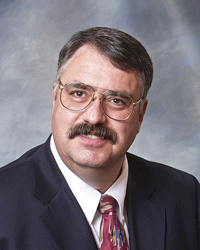|
 |
BEN BLOYS, Manager, Los Alamos Technology Alliance, Chevron Corp.
|
I looked back at the expectations that I had written for 2013, and not too much has changed. Chevron seems to be on a steady path to increase production in a safe, reliable manner, but, as always, there are challenges.
Safety and environmental responsibility continue to be core values for us. Our record has improved steadily, but the ultimate goal is zero spills and zero people injured. “Do it safely or not at all” and universal “Stop Work Authority” are deeply embedded in our culture. Advanced training, and programs like WELLSAFE for enhanced well control, helps everyone remember to stay focused on safety issues every day.
Major deepwater projects continue their progress. We have five rigs running in the Gulf of Mexico, steadily developing and expanding a string of Lower Wilcox discoveries. We expect Big Foot and Jack/St. Malo fields to be online by the end of 2014. Greater Gorgon, the giant LNG project off the northwestern coast of Australia, is about 70% complete, with first gas expected in late 2014. Wheatstone is not far behind, and both projects have long-term contracts for almost all of their expected gas production.
The string of subsequent Chevron discoveries in the area since 2009 now numbers 21, so the deep waters off northwestern Australia will be a major focus area for us over several decades. However, rising labor and material costs present an ongoing challenge. Newer deepwater blocks off Brazil, China and West Africa will be evaluated in 2014.
Shale/unconventional formations continue to present huge new opportunities. The boom in shale plays is highlighted by Texas having almost a quarter of all the world’s active drilling rigs. Chevron is building a new, 330,000-sq-ft office complex in Midland, to accommodate the personnel necessary to develop the Wolfcamp and other plays in the Delaware basin area. This rapid expansion is running head-on into the “great crew change,” as highly experienced employees are retiring at an accelerating pace.
Chevron is countering the trend with creative hiring, expanded training, aggressive mentoring programs, half-time work schedules for semi-retirees, and the “Bridges” program, where retirees come back on a contracting basis.
Internationally, shale programs are getting started slowly. The first wells in the Duvernay shale of Canada look promising. Our first few wells in Poland and Lithuania are being analyzed, while other Eastern Europe/FSU opportunities are in the early stages of evaluation, including a recent agreement in the Ukraine. New deals have also been signed for the Vaca Muerta shale in Argentina, the Karoo in South Africa, and the Cooper basin in Australia.
The sheer volume of shale around the world represents fascinating potential, but the industry is fairly low on the technology curve for these unconventional formations. What is the optimal well spacing? How can we improve initial productivity? How can we improve ultimate recovery? How do we identify sweet spots? The questions go on and on.
Technology continues to be a major focus for Chevron. Technology will help us answer some of the industry’s most challenging questions—how do we deal with water depths greater than 10,000 ft, bottomhole temperatures over 500°F, and reservoir pressures in excess of 25,000 psi? How do we bring down well costs, improve safety, improve refining margins, get better recovery from shales, etc.? Keeping up with, and properly using, current technology is tough enough, but developing new approaches to deal with the remaining technology gaps is an added challenge.
Our technology alliances with Los Alamos National Lab and NASA’s Jet Propulsion Lab continue to deliver innovative, high-value solutions. The real-time, wireless downhole pressure and temperature monitoring system, downhole liquid level monitoring system, and two-phase flowmeter mentioned last year are all quickly expanding their applications. Several new technologies are just now entering the commercialization phase of their life cycle. We’re making progress on a full three-phase flowmeter, an enhanced, long-distance logging tool concept, and we may soon have an acoustic camera that gives us those “downhole glasses” that we have always dreamed about.
Dual-gradient drilling is making progress, and should be fully operational in late 2013/early 2014. Managing “big data” and drawing useful information from it continues to be an ongoing challenge for drilling, reservoir management, refining, etc. And the battle to keep all of that data secure is becoming more and more challenging. 
The author
BEN BLOYS is the manager for Chevron’s technology alliance with Los Alamos National Laboratories. He also manages Chevron’s R&D program at the Tulsa University Center of Research Excellence. Mr. Bloys has developed technology in a number of areas, including drilling fluids, low-invasion coring, drilling waste management and gas hydrates. He worked for 17 years at the ARCO Technology Center, before joining Chevron in 2000. Mr. Bloys holds a BS degree in chemistry from Angelo State University (1983). He has 33 technical publications and 19 patents, and is a member of SPE, AADE, ACS and API. |
|



